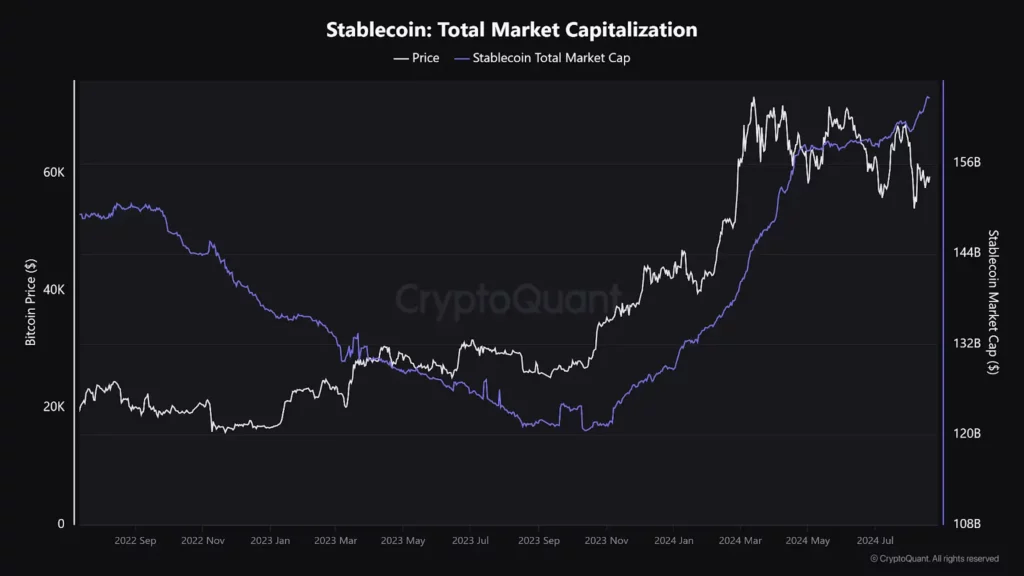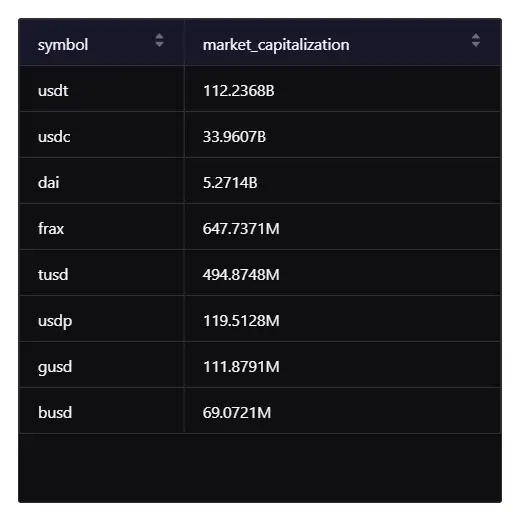The stablecoin market has reached a new benchmark, with its overall capitalization growing to $165 billion. This comeback follows a recovery approaching the $180 billion high seen prior to the Terra/Luna event. Such an increase in the value of stablecoins coincides with any upcoming bullish trends that might happen on Bitcoin and generally throughout all crypto.
A range of factors, including growing use for trading stablecoins, new integrations with DeFi protocols, and safe-haven assets during volatile market climates, has driven this growth. Demand for stablecoins has exploded, with more and more traders & investors looking to hedge against the volatile nature of crypto prices.
Stablecoins are also widely used for liquidity management, with stablecoin pairs accounting for over 80% of daily crypto trading volume. Cross-border payments and remittances are some use cases that have helped associations expand their adoption, mainly in areas with inadequate local currencies.
Due to their unregulated use, digital cash, including stablecoins and crypto-assets, poses manifold risks. This digital cash can lead to systemic risks such as leverage and liquidity mismatches, causing market disruptions. Lack of regulation can also lead to consumer harm, fraud, and criminal activities like money laundering and terrorist financing.
As these virtual assets become more interlinked with traditional financial systems, the potential for contagion effects increases. Strong regulation is essential to avoid large-scale financial crises. The Financial Stability Board and the International Monetary Fund emphasize the need for comprehensive international standards to address these risks without stifling innovation.
Regulatory Compliance and the Future of Stablecoins
Global regulators also want increased oversight on stablecoin projects to ensure financial stability, market integrity, and, in the long term, consumer protection. Stablecoin issuers have only recently become subject to broad international standards, including the guidelines from the Financial Stability Board (FSB) in July 2023 and those published by the Basel Committee on Banking Supervision (BCBS) in December 2022 that establish governance expectations, risk management requirements, and reserve asset disclosure for stablecoin issuers.
They are building on previous guidance outlined in the Committee on Payments and Market Infrastructures (CPMI) and the International Organization of Securities Commissions’ principles for addressing financial market infrastructures that are systemically important, such as stablecoins.
This translates into robust governance structures that are part of the regulatory frameworks in most jurisdictions, requiring stablecoin issuers to have top management with a track record and reputation strength sufficient for handling those risks. Moreover, these frameworks require the setting up of robust operational risk management systems to prevent cyber security threats and anti-money laundering (AML) issues, as well as protect consumers/investors.
“Stablecoins may still be unregulated or lightly regulated,” said Johannes Ehrentraud, Senior Advisor at the FSI. There is no globally harmonized rule and no international rule.” Ehrentraud went on to discuss regulating and supervising crypto, stablecoins, and tokenized assets.
Reserve asset management is essential to stablecoins’ stability and reliability. It must be subject to solid policies such as those concerning credit risk, liquidity risk, or risks related to exposures in relation to other holdings. Yet, regarding stablecoins’ reserve assets, transparency is not uniform among jurisdictions—a factor that may contribute to which types are classified as more or less stable.
Global Trend Picks Up Stablecoins
While the stablecoin market is forecast to have a $2.8 trillion valuation by 2028, regulators are beginning to hone their regulation frameworks in order to stay caught up with innovation while protecting systemic risks for financial stability within their economy. It is imperative that as stablecoins take a more significant foothold in the economic landscape, they be underpinned by transparency and strict compliance with regulations to ensure trust. Consistent with this trend, the Bank of England (BoE) is refining its money and payments strategy by developing proofs-of-concept on Distributed Ledger Technology (DLT) as well as exploring potential wholesale Central Bank Digital Currencies (wCBDCs).
Even as the BOE adapts to support “a modern, innovative and dynamic U.K. economy,” Governor Andrew Bailey said that money must remain a source of confidence even if consumers move further towards electronic payments or private currency tokens in place of paper banknotes. These developments align with the importance of stablecoins in cross-border transactions and underscore a growing necessity for regulatory frameworks that balance stability and innovation amidst an ever-changing financial ecosystem, as emphasized by Ripple introducing RLUSD, its U.S. dollar-backed stablecoin to XRP Ledger.
Source: https://www.cryptonewsz.com/stablecoins-reach-165b-market-cap-whats-next/



